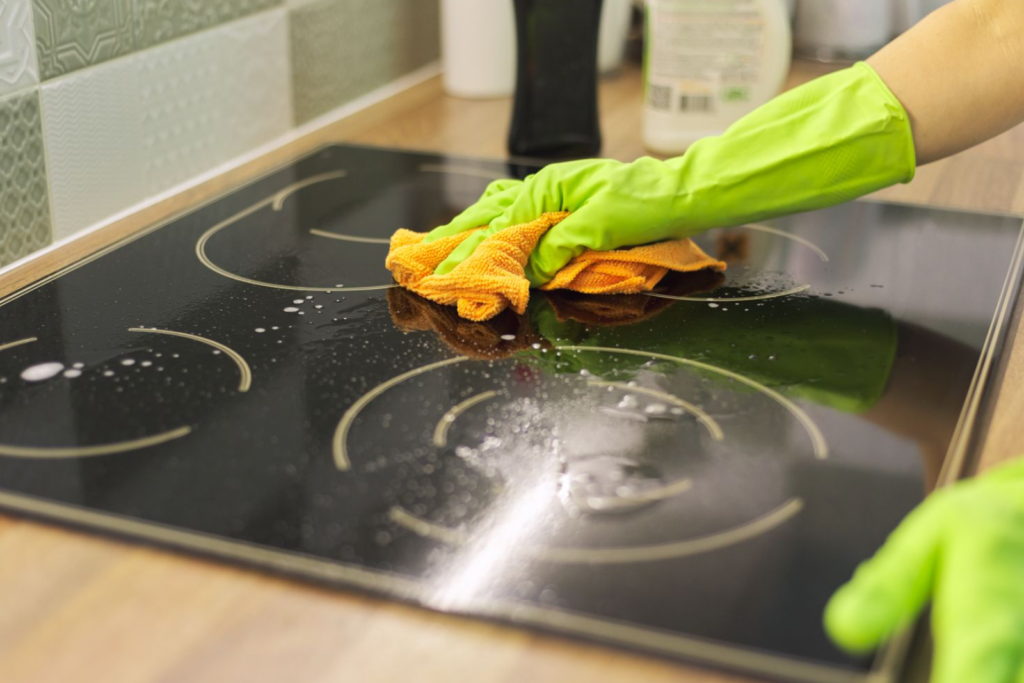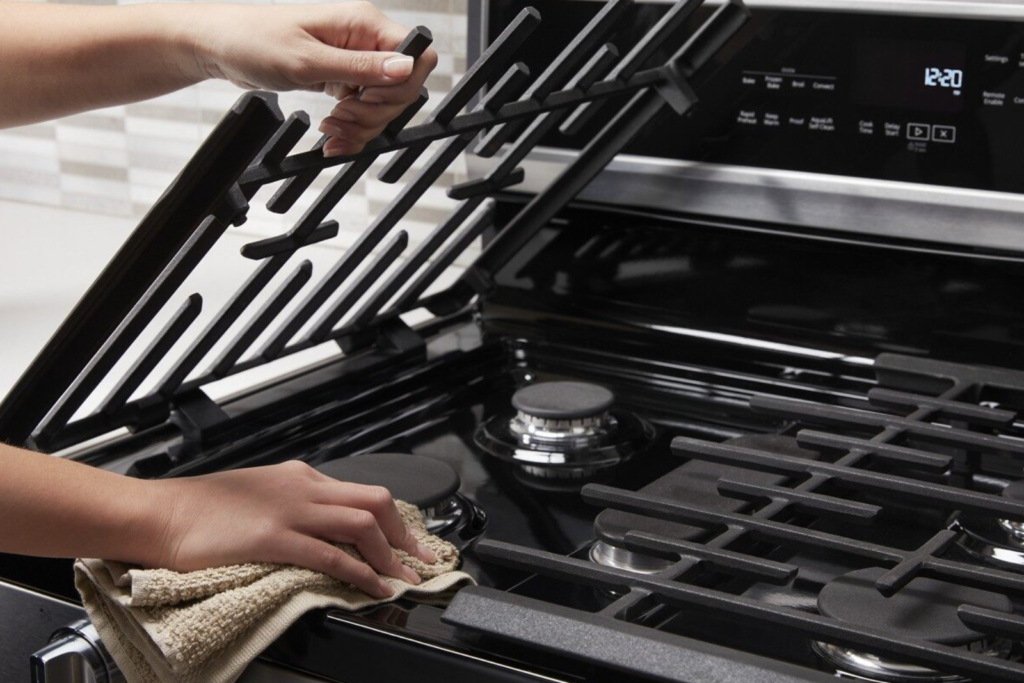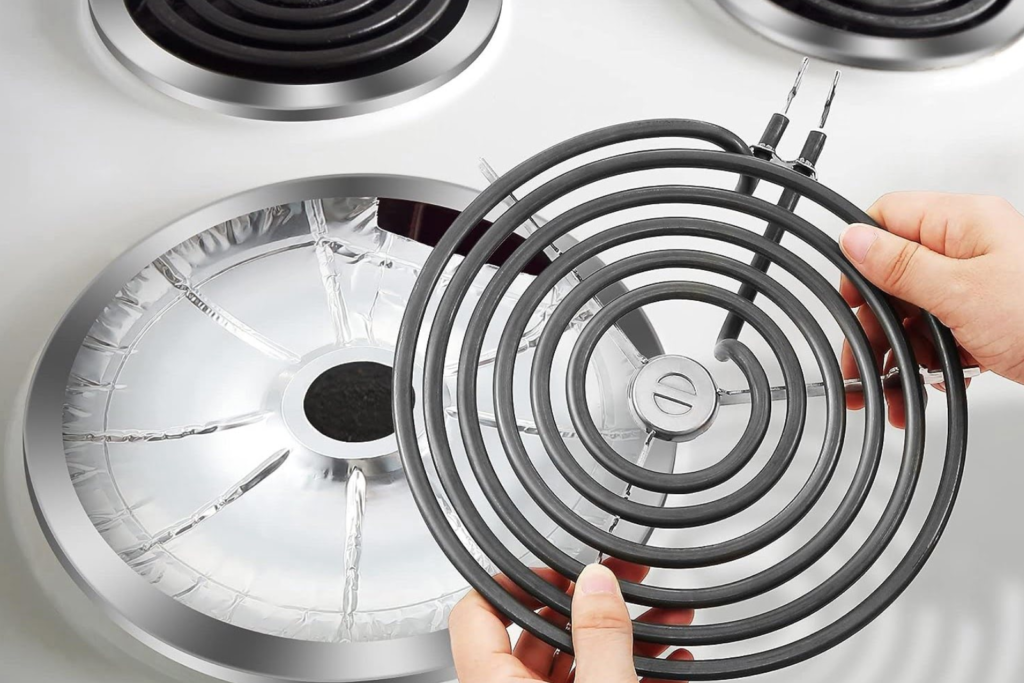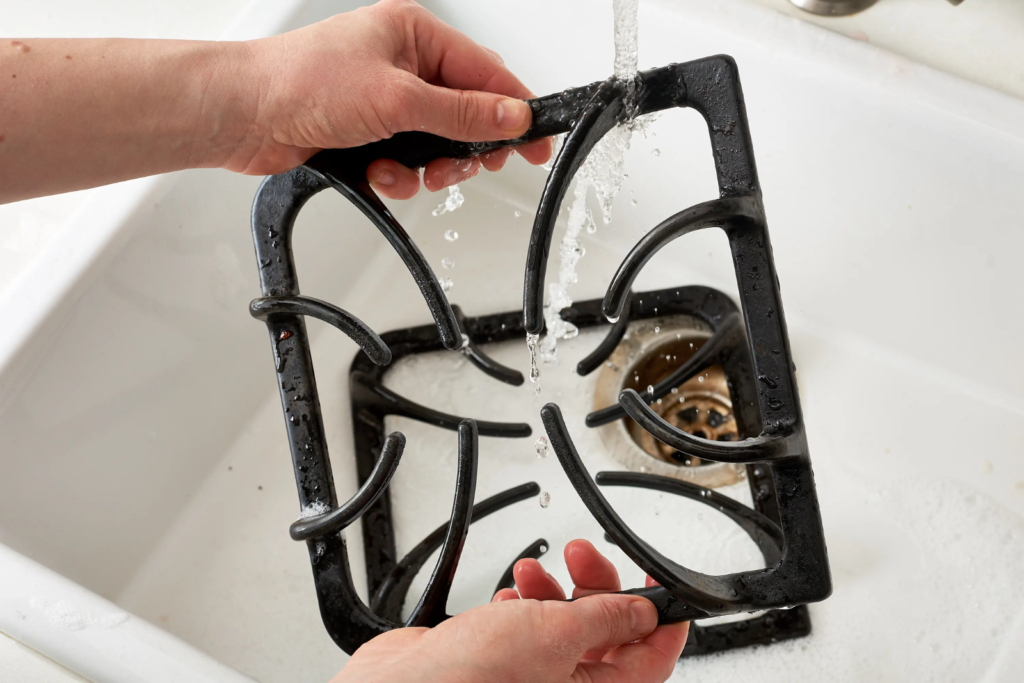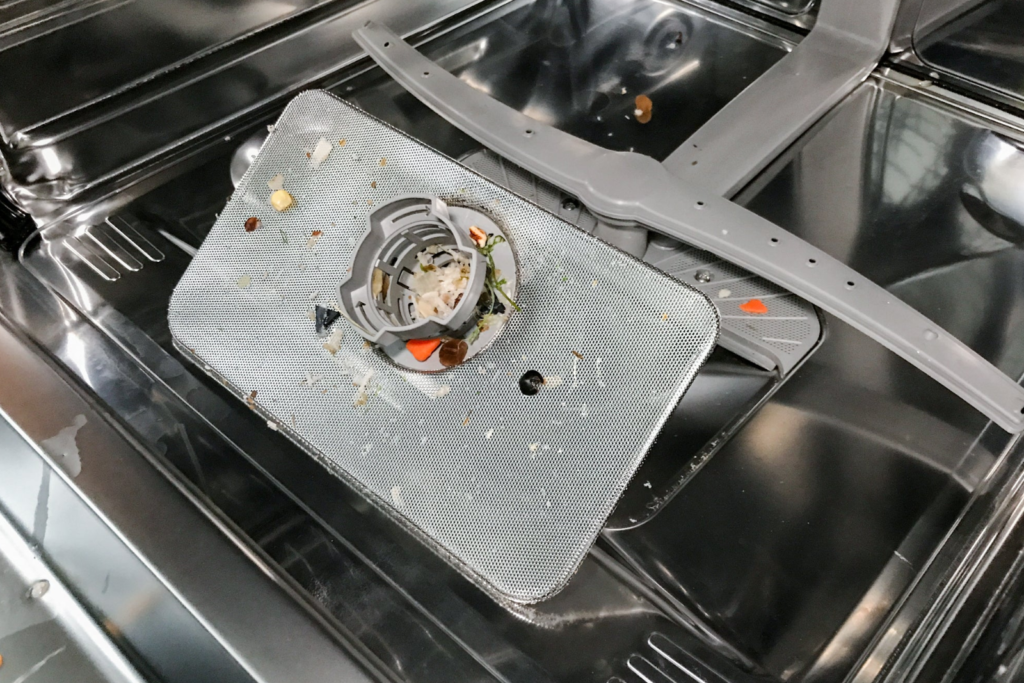A glass-ceramic stove top is a sleek and modern addition to any kitchen. Not only does it look attractive, but it’s also relatively easy to clean and maintain. To keep your glass-ceramic stove top looking pristine and functioning efficiently, follow these steps for effective cleaning.
Materials You’ll Need
Before you get started, gather the following materials:
- Warm soapy water
- White vinegar
- Baking soda
- Soft cloth or sponge
- Razor blade scraper (specifically designed for glass-ceramic surfaces)
- Microfiber cloth or paper towels
- Dishwashing gloves
Step-by-Step Guide
Now that you have all the necessary materials, let’s get started on cleaning your glass-ceramic stove:
Step 1: Safety First
Ensuring your glass-ceramic stove top is completely turned off and has had time to cool down is the paramount step when it comes to cleaning a glass-ceramic stove top. Safety must always be the top priority when working with kitchen appliances, and here’s why:
- Preventing Burns and Injuries: Glass-ceramic stove tops, like any cooking surface, can become scalding hot during use. Attempting to clean a still-warm or hot stove top poses a significant risk of burns and injuries. The high temperatures can cause severe skin burns on contact. Even when turned off, the residual heat can linger for some time, making it essential to allow the surface to cool down completely before proceeding with any cleaning.
- Minimizing the Risk of Accidents: Cleaning a hot stove top can be a recipe for accidents. Spills and cleaning solutions can react with the heat, leading to unexpected flares or the release of noxious fumes. By waiting for the stove top to cool, you avoid these potential dangers.
- Protecting the Appliance: Rapid temperature changes, such as applying cold cleaning solutions to a hot glass-ceramic surface, can also stress the glass, potentially leading to thermal shock and damage to the stove top. Allowing the stove to cool naturally minimizes this risk and helps protect your appliance’s longevity.
- Ensuring Effective Cleaning: Cleaning a hot stove top may also hinder the effectiveness of your cleaning efforts. Stains and spills tend to bake onto the surface when hot, making them more challenging to remove. Waiting for the stove top to cool ensures that your cleaning process is more efficient and that you can easily tackle any residue.
In summary, the “Safety First” step is not only about protecting yourself and others from potential injuries and accidents but also about safeguarding the integrity of your glass-ceramic stove top and ensuring a more effective cleaning process. Always make it a habit to prioritize safety when cleaning any kitchen appliance, and in the case of a glass-ceramic stove top, this involves allowing it to cool down completely before you begin the cleaning process.
Tip:
- Make it a routine to double-check the stove’s temperature. Even when it appears cool, the glass-ceramic surface may still retain some heat.
- Ensure that all control knobs are in the “off” position and disconnect the power supply if applicable.
- Keep children and pets away from the stove during the cleaning process for added safety.
Don’t: Don’t attempt to clean your glass-ceramic stove top if it is still hot or warm. Cleaning a hot surface can lead to burns, accidents, and potential damage to the stove top. Always ensure it is completely turned off and has had time to cool down before beginning the cleaning process.
Step 2: Wipe Away Loose Debris
Once you’ve ensured the safety of a completely cooled glass-ceramic stove top, it’s time to remove loose debris that can accumulate from cooking. This step involves using a soft cloth or sponge to gently wipe away loose debris, such as food crumbs and spills. Here’s why this step is crucial:
- Preventing Scratches: Glass-ceramic surfaces are highly durable, but they can be susceptible to scratches, especially when abrasive particles are present. Any small food crumbs or debris left on the stove top can act like tiny abrasives when you start cleaning, potentially causing scratches or damage to the surface. By wiping away loose debris first, you minimize the risk of these particles causing harm.
- Enhancing Cleaning Effectiveness: Removing loose debris beforehand makes the overall cleaning process more efficient. It ensures that the cleaning solutions and tools can directly target stains and residue rather than having to contend with surface clutter. This step sets the stage for a more thorough and effective cleaning experience.
- Maintaining Appliance Appearance: Glass-ceramic stove tops are known for their sleek and attractive appearance. Regularly clearing away loose debris helps to preserve this aesthetic by preventing a buildup of unsightly stains and remnants of past meals. It keeps your stove top looking clean and inviting.
To carry out this step effectively, use a soft cloth or sponge. Ensure that the cloth or sponge is free from any rough or abrasive surfaces that could scratch the glass. By gently wiping away loose debris, you’re setting the foundation for a successful and safe cleaning process that will leave your glass-ceramic stove top looking its best.
Tip:
- Use a soft cloth or sponge specifically designated for your glass-ceramic stove top to avoid introducing any potential abrasive particles.
- If you have a spill or boil-over, wipe it up as soon as it happens to prevent it from baking onto the surface.
Don’t: Don’t use abrasive materials or harsh scouring pads that can scratch or damage the glass-ceramic stove top.
Step 3: Create a Cleaning Solution
The next step in the process of cleaning your glass-ceramic stove top is to create a cleaning solution. This solution, made from a mixture of equal parts white vinegar and warm water in a spray bottle, is your key to effectively removing stains and grime. Here’s why this solution works so well:
- Natural and Safe: White vinegar is a natural and safe cleaning agent that’s readily available in most households. It’s known for its excellent degreasing and stain-removing properties, making it ideal for cleaning glass-ceramic surfaces without the need for harsh or abrasive chemicals.
- Dissolves Stains and Residue: The acidity of white vinegar helps break down and dissolve tough stains, burnt-on food, and grease that may have accumulated on your stove top. This makes it easier to wipe away stubborn residue during the cleaning process.
- Non-Abrasive: Unlike some commercial cleaning products that can be abrasive and potentially harm the glass-ceramic surface, the vinegar and water solution is gentle and won’t scratch or damage your stove top. This ensures that your appliance remains in good condition.
- Leaves No Residue: When properly diluted, the vinegar solution leaves no sticky or soapy residue on the glass-ceramic surface, resulting in a streak-free and shiny finish.
To create the cleaning solution, mix equal parts white vinegar and warm water in a spray bottle. This solution will be your go-to tool for tackling stains and grime on your glass-ceramic stove top. It’s an eco-friendly and cost-effective alternative to harsh chemical cleaners, making it an excellent choice for your kitchen cleaning needs.
Tip:
- Mix the vinegar and water solution in a well-ventilated area, as vinegar can have a strong odor.
- If you have concerns about the vinegar smell, you can add a few drops of essential oil (such as lemon or orange) to the solution for a more pleasant scent.
Don’t: Don’t use abrasive or gritty cleaning products or powders that can damage the glass-ceramic surface. Stick to mild, non-abrasive cleaners.
Step 4: Apply the Cleaning Solution
With your vinegar and water cleaning solution in hand, it’s time to apply it to your glass-ceramic stove top. Follow these steps for effective application:
- Generously Spray the Solution: Hold the spray bottle containing the vinegar and water solution a few inches above the stove top, and generously spray it over the entire surface. Ensure even coverage, but pay extra attention to areas with stains, spills, or sticky residue. The vinegar solution will begin to work on breaking down the grime and making it easier to clean.
- Allow it to Sit: After applying the cleaning solution, allow it to sit for a few minutes. This “soaking” period is essential as it gives the vinegar time to soften and loosen stubborn stains and residue. The waiting time may vary depending on the severity of the stains, but typically, a few minutes should suffice.
The application of the vinegar and water solution is a critical step in the cleaning process. The acidity of the vinegar helps in breaking down the grime, making it easier to remove in the subsequent steps. Patience during the waiting period ensures that the solution has enough time to work its magic, making the cleaning process more efficient and less labor-intensive.
Tip:
- For stubborn stains, you can gently lay a damp cloth or paper towel soaked in the vinegar solution over the affected area for a few minutes to help soften the residue.
- Keep the vinegar and water solution spray bottle handy throughout the cleaning process for spot treatments.
Don’t: Don’t allow the vinegar and water cleaning solution to dry on the surface, as it may leave behind streaks or water spots. Always wipe it away promptly.
Step 5: Scrub Gently
Now that the vinegar and water solution has had time to loosen grime and stains, it’s time to gently scrub the glass-ceramic stove top. This step is crucial for removing stubborn residue and restoring the surface’s shine. Here’s how to do it effectively:
- Use a Soft Cloth or Sponge: To avoid scratching the glass-ceramic surface, select a soft cloth or a non-abrasive sponge. Make sure that the cloth or sponge is free from any rough or abrasive textures that might harm the glass.
- Circular Motion: Start by gently scrubbing the stove top in a circular motion. Applying gentle pressure is key, as excessive force can result in scratches or damage to the surface. The circular motion helps evenly distribute the cleaning effort and minimizes the risk of scratching.
- For Stubborn Stains: If you encounter particularly stubborn stains or burnt-on residue, sprinkle a small amount of baking soda directly onto the affected area. Baking soda acts as a mild abrasive that can assist in breaking down and removing tough stains without scratching the glass-ceramic surface.
- Be Patient: Allow the cloth or sponge, along with the cleaning solution and baking soda if used, to work on the stains. You may need to apply a bit more elbow grease for persistent stains, but always prioritize gentleness to avoid damaging the surface.
Gently scrubbing the stove top is the heart of the cleaning process. It’s where you physically remove the loosened grime and stains, leaving behind a sparkling surface. Proper tools, a gentle touch, and patience are your allies in ensuring your glass-ceramic stove top looks its best.
Tip:
- When using baking soda, create a paste by mixing it with a small amount of water. Apply the paste to stains, let it sit for a few minutes, and then gently scrub.
- Regularly inspect your cleaning cloth or sponge during this step to ensure it’s free of debris that could scratch the glass.
Don’t: Don’t apply excessive pressure while scrubbing; a gentle touch is essential to avoid scratching the glass-ceramic surface.
Can I use metal scouring pads or abrasive sponges for tough stains?
Avoid using metal scouring pads or abrasive sponges on your glass-ceramic stove top, as they can scratch the surface. Instead, employ a soft cloth or non-abrasive sponge for cleaning. Stubborn stains may be treated with baking soda as a milder abrasive.
Step 6: Remove Residue
After you’ve gently scrubbed the glass-ceramic stove top to eliminate grime and stains, it’s time to remove any remaining residue and achieve a spotless finish. Here’s how to do it effectively:
- Wipe Away with a Damp Cloth: Using a clean, damp cloth, thoroughly wipe away the cleaning solution and any loosened grime. The damp cloth will pick up the residue, ensuring that your stove top is clean and free of any remaining cleaning solution.
- For Stubborn Residue: In case you encounter burnt-on food or particularly stubborn stains that resist conventional cleaning, you can use a razor blade scraper designed for glass-ceramic surfaces. These specialized scrapers are safe for use on glass-ceramic stoves and help remove persistent residue.
- Caution with the Scraper: When using a razor blade scraper, hold it at a shallow angle to the glass-ceramic surface. This minimizes the risk of scratching the glass. Gently and carefully scrape away the residue without applying too much pressure.
This step ensures that your glass-ceramic stove top is not only clean but also free from any remaining cleaning product or grime. It’s vital to use the razor blade scraper cautiously, reserving it for instances where stubborn residue needs to be addressed. With this approach, your stove top will shine and look as good as new.
Tip:
- If a razor blade scraper is needed, be cautious and maintain a shallow angle to prevent scratching. Always use a dedicated glass-ceramic scraper for this purpose.
- In case of any accidental scratches, there are specialized glass-ceramic cooktop polish and scratch removers available to help restore the surface’s appearance.
Don’t: Don’t use a razor blade scraper on the glass-ceramic surface unless you have a specialized scraper designed for such surfaces, and even then, use it cautiously to prevent scratches.
Step 7: Dry and Polish
The final step in the process of cleaning your glass-ceramic stove top involves drying and polishing to ensure a pristine finish. Follow these steps for a spotless, streak-free appearance:
- Use a Microfiber Cloth or Paper Towels: To dry the stove top thoroughly, grab a clean microfiber cloth or paper towels. These materials are excellent for absorbing moisture and preventing streaks and water spots.
- Dry the Surface: Gently dry the entire stove top surface, ensuring that there is no residual moisture left. This step is vital for preventing water spots or streaks from forming, which can diminish the overall appearance of your stove top.
- Polish for a Sparkling Finish: For an extra touch of shine, you can apply a small amount of white vinegar to the surface. Using a separate clean cloth, polish the stove top in a circular motion. White vinegar acts as a natural and effective glass cleaner, leaving your glass-ceramic stove top gleaming.
- Inspect for Streaks: After polishing, take a moment to inspect the stove top for any streaks or water spots. If you notice any, simply go over those areas with a clean, dry section of the microfiber cloth or paper towels until the surface is streak-free.
This final step ensures that your glass-ceramic stove top not only looks clean but also gleams with a polished finish. It’s the key to achieving that attractive, pristine appearance that makes your kitchen feel inviting and well-maintained.
Tip:
- To avoid streaks, use a clean, dry, and lint-free microfiber cloth or paper towels for drying and polishing.
- If the stove top remains streaky, you can repeat the drying and polishing step with a fresh, dry cloth or paper towels.
- Regularly maintain your glass-ceramic stove top to reduce the need for deep cleaning and heavy polishing.
Don’t: Don’t use an excessive amount of vinegar for polishing, as this can leave a strong vinegar odor in your kitchen. A little goes a long way.
Is it okay to use glass-ceramic stove top cleaners and polishers available in stores?
Yes, it is generally okay to use glass-ceramic stove top cleaners and polishers available in stores. However, it’s essential to follow the manufacturer’s recommendations and use them in accordance with your stove’s care guidelines to ensure effective and safe cleaning.
Other related questions
Can I use commercial stove-top cleaners on my glass-ceramic stove top?
Commercial stove-top cleaners are generally not recommended for glass-ceramic surfaces, as they can be abrasive and may scratch the glass. Instead, opt for mild, non-abrasive cleaners like a vinegar and water solution. These are effective and safe for cleaning without causing damage to the glass-ceramic stove top.
Is it necessary to clean the glass-ceramic stove top after every use?
Cleaning the glass-ceramic stove top after every use is not necessary. However, promptly wiping away spills and debris is a good practice to prevent residue from hardening and becoming more challenging to remove. A thorough cleaning as needed, based on usage, will help maintain its appearance and efficiency.
How often should I clean my glass-ceramic stove top?”
The frequency of cleaning your glass-ceramic stove top depends on your usage. However, a general guideline is to perform a thorough cleaning every 1-2 weeks. For heavily used stoves or to prevent stubborn stains, more frequent cleaning may be necessary. Wiping spills and splatters promptly after each use can help maintain its appearance between deep cleanings.
What should I do if I accidentally scratch my glass-ceramic stove top while cleaning?
If you accidentally scratch your glass-ceramic stove top while cleaning, specialized glass-ceramic cooktop polish and scratch removers are available. Follow the product’s instructions for repair. Regular cleaning and maintenance can also help prevent further damage and maintain the appearance of your stove top.
Can I use bleach or ammonia-based cleaners on a glass-ceramic stove top?
It is not recommended to use bleach or ammonia-based cleaners on a glass-ceramic stove top. These harsh chemicals can potentially damage the glass surface and leave streaks. Opt for mild, non-abrasive cleaners like a vinegar and water solution for safe and effective cleaning.
Can I use the same cleaning method for a gas or coil stove top on a glass-ceramic stove top?
No, the cleaning methods for gas or coil stove tops are not suitable for a glass-ceramic stove top. Glass-ceramic surfaces are more delicate and require different cleaning approaches to prevent damage or scratching. Stick to the methods and solutions specifically designed for glass-ceramic stove tops for safe and effective cleaning.

